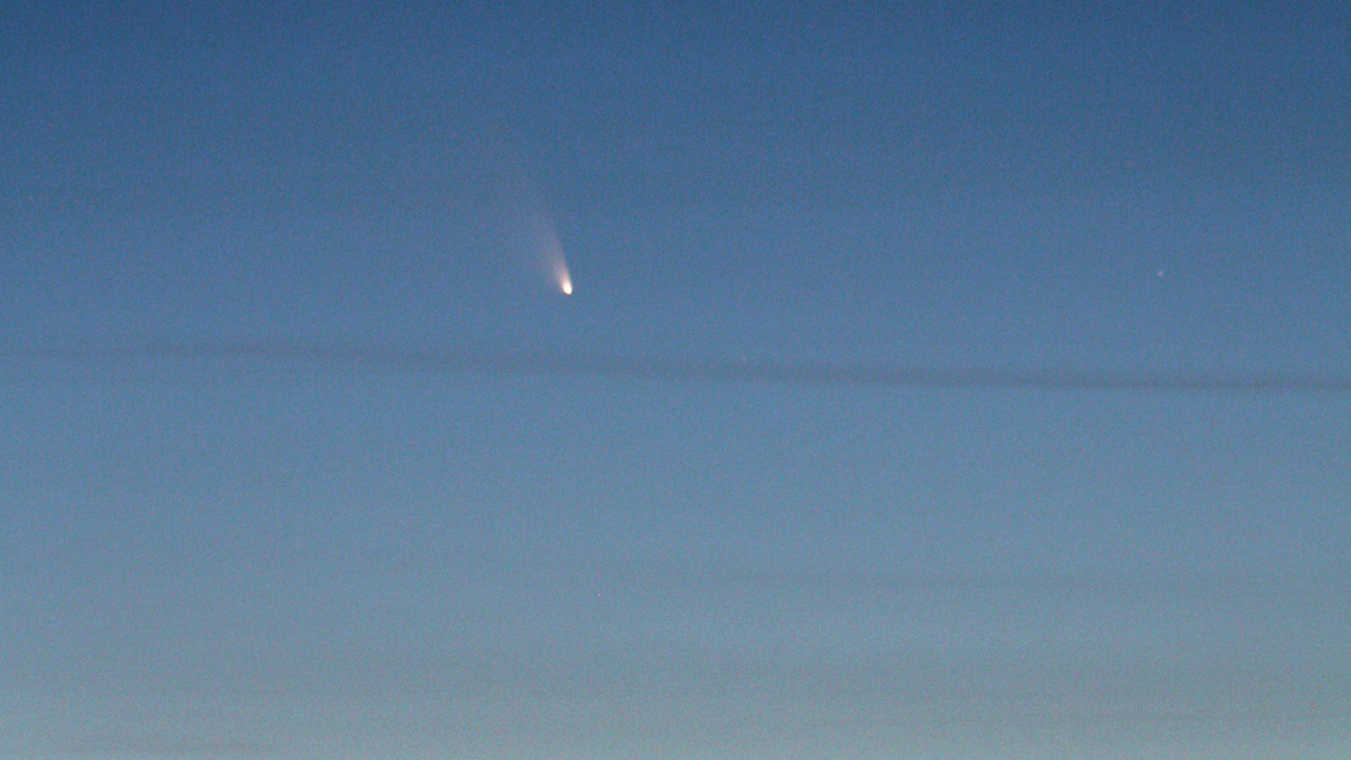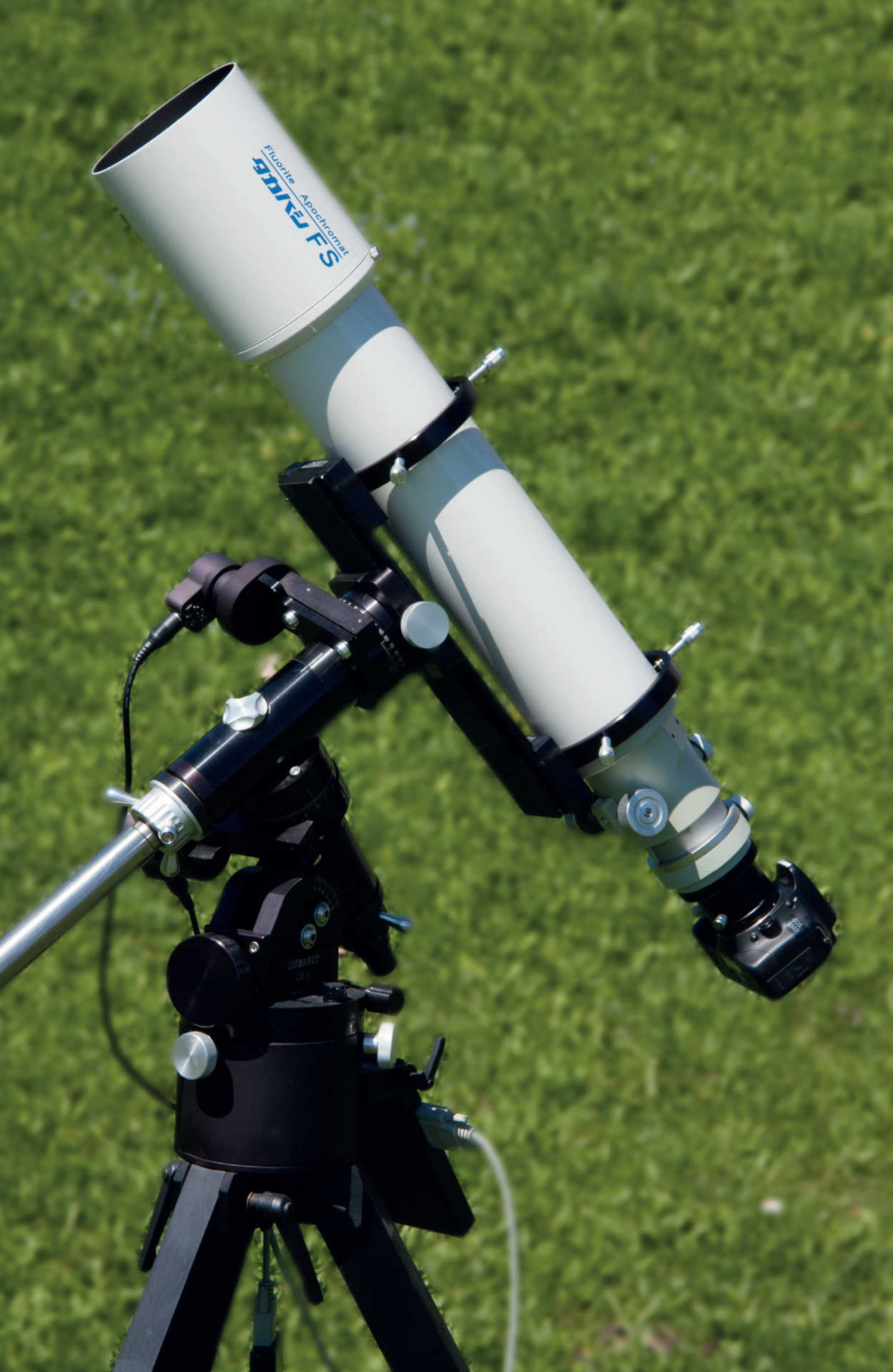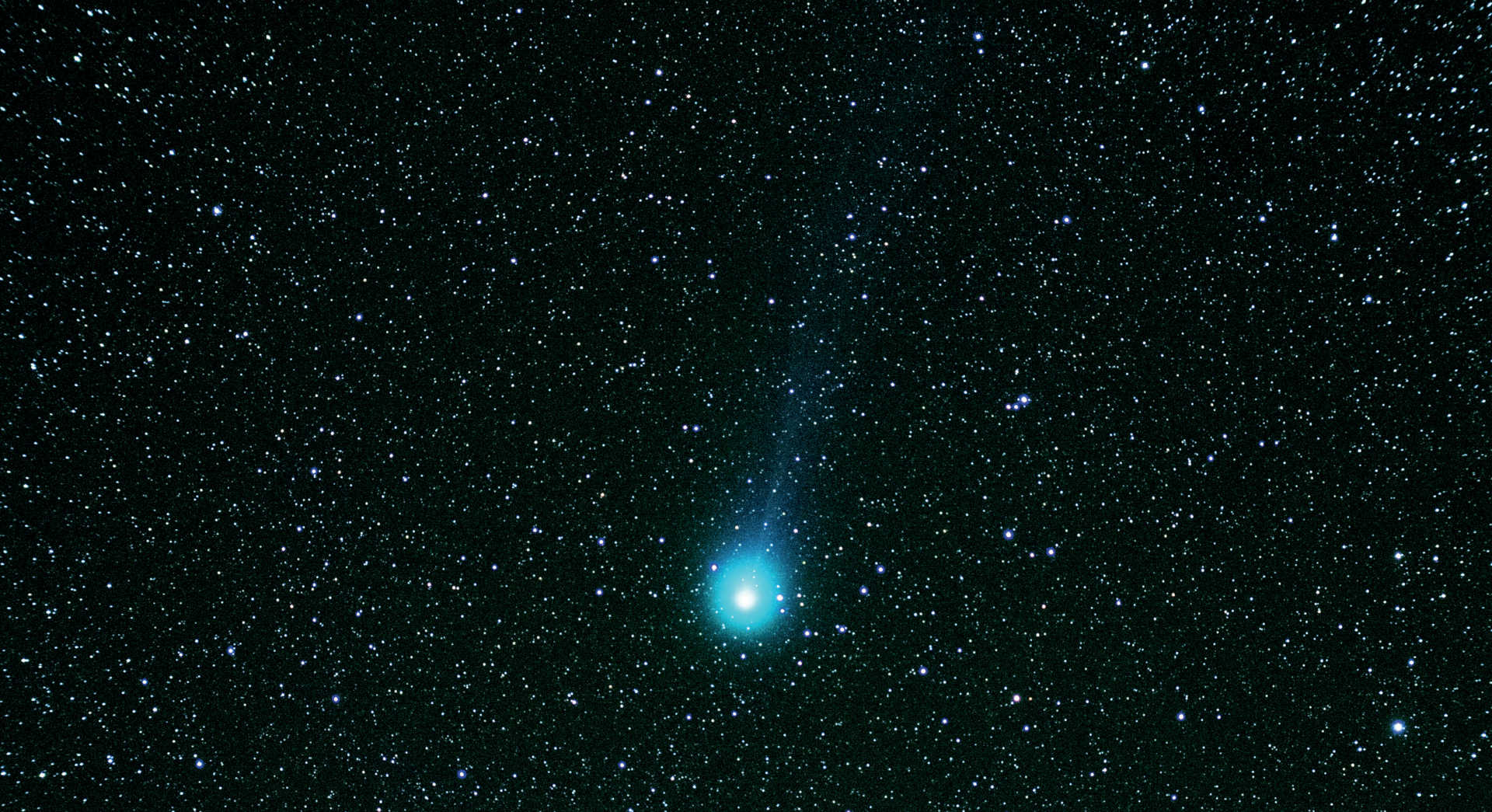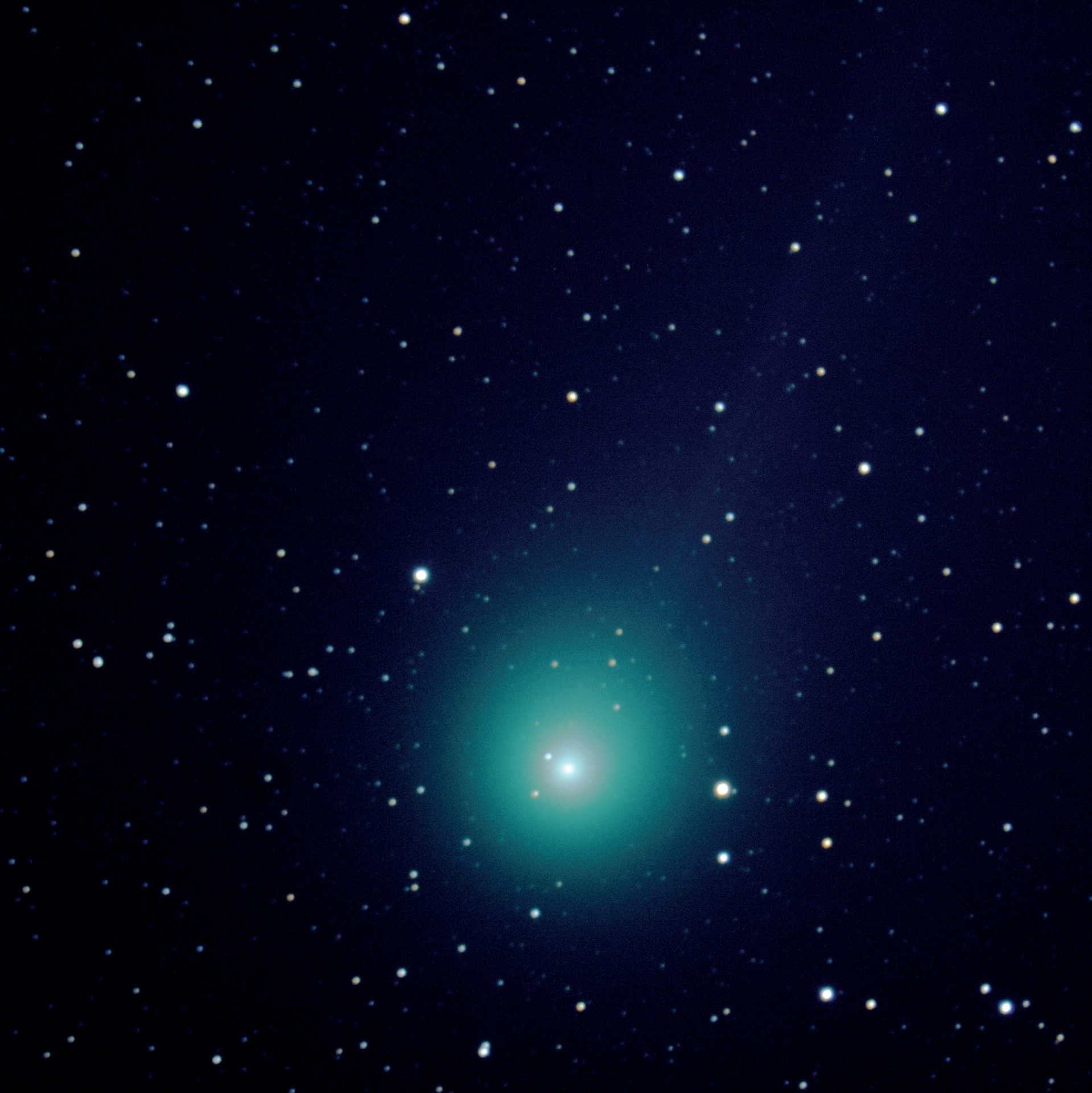Comet photography. Equipment and preparation.
Comets are attractive and easy to photograph – providing you prepare carefully and have the right equipment.
 Comet C/2011 L4 (PanSTARRS) at dusk above the Black Forest. The single shot was taken on 15 March 2013 shortly after sunset with a Canon D550 DSLR and a telephoto lens with 300 mm focal length. U. Dittler
Comet C/2011 L4 (PanSTARRS) at dusk above the Black Forest. The single shot was taken on 15 March 2013 shortly after sunset with a Canon D550 DSLR and a telephoto lens with 300 mm focal length. U. DittlerComets are easy to photograph using your existing telescope and a DSLR
Comets have a special appeal to many amateur astronomers: they differ in size, shape and brightness and always provide varying and fascinating views as they roam across the night sky. Success with comet photography depends on careful planning and the appropriate equipment.
You’ll need three things for successful comet photography: a stable mount, a telescope and an adaptable camera. The mount should be able to safely carry and track the telescope/camera combination. As the exposure times for comet photography are usually in the range of a few minutes, tracking accuracy is not subject to the high demands that are always the case with deep sky photography. Nevertheless, a stable mount with reliable tracking is essential. In order to be able to locate comets – especially the fainter ones – more easily, you’ll need to set up and align your mount precisely. GoTo functionality can also be very helpful.
Spectacular subjects
 Most amateur astronomers will already own the hardware required for comet photography: a stable mount, a telescope (here a refractor with a focal length of around 1,000 mm) and an adaptable DSLR. U. Dittler
Most amateur astronomers will already own the hardware required for comet photography: a stable mount, a telescope (here a refractor with a focal length of around 1,000 mm) and an adaptable DSLR. U. DittlerEven telescopes with shorter focal lengths, for example between 500mm and 1,000mm, are suitable for comet photography, as these short focal length instruments make it possible to depict the comets against the background of the stars and constellations among which they roam. Although the comets themselves will not be especially high-resolution, if your frame is large enough then the deep sky objects that the comet passes can be captured together with the comet itself – which will deliver a quite spectacular comet image.
If you want the comet’s nucleus to be clearly visible in the images, then you can of course use a telescope with a considerably longer focal length, such as the familiar Schmidt Cassegrain telescopes with a 2,000 mm focal length. However locating the comet may be a little more difficult with these telescopes, due to the smaller field of view and the usually lower light intensity. But here too, star-hopping or a GoTo mount will help you succeed in your search.
Comets are not only exciting astrophotography targets due to the shape of the comet's head and tail(s), but also because they usually glow green and, due to their vividness, stand out clearly against the dark night sky with its mostly white shining stars. This vividness can be captured very easily if a DSLR is attached focally to the telescope for photography (alternatively a cooled CCD camera with a filter set could also be used).
Planning and preliminary considerations
When choosing a comet to photograph, one important criterion is definitely its brightness and the question of whether the comet is still in its increasing brightness phase, or has already exceeded its maximum brightness and its luminosity is decreasing again. Also the comet’s position and its track across the sky should be considered, since comets are of course easiest to observe and photograph when they are at their maximum height above the horizon. Faint comets close to the horizon will often appear far less impressive in the haze of the horizon compared to when they are high in the sky. Very bright comets, such as comet C/2011 L4 (PanSTARRS), which could be seen even shortly after sunset in 2013, are very rare. Fainter comets up to around magnitude 10 are much more common, but these too can be easily located and photographed with the above-mentioned equipment.
 Comet C/2014 Q2 (Lovejoy) with a short focal length refractor. Composite image captured on 7 March 2015 using a Canon D550 DSLR on a 355-mm apo refractor with a 60-mm aperture. Five shots each with an exposure time of 120 seconds (total exposure time: 10 minutes) were combined with DeepSkyStacker and Photoshop for the total image. U. Dittler
Comet C/2014 Q2 (Lovejoy) with a short focal length refractor. Composite image captured on 7 March 2015 using a Canon D550 DSLR on a 355-mm apo refractor with a 60-mm aperture. Five shots each with an exposure time of 120 seconds (total exposure time: 10 minutes) were combined with DeepSkyStacker and Photoshop for the total image. U. Dittler Comet C/2014 Q2 (Lovejoy) with a long focal length Schmidt Cassegrain telescope. Composite image captured on 7 March 2015 just a few minutes after the image above, using a Canon D550 DSLR on a 2000-mm telescope with 2,000 mm focal length and a 280-mm aperture. Five shots each with an exposure time of 120 seconds (total exposure time: 10 minutes) were combined with DeepSkyStacker and Photoshop for the composite image. U. Dittler
Comet C/2014 Q2 (Lovejoy) with a long focal length Schmidt Cassegrain telescope. Composite image captured on 7 March 2015 just a few minutes after the image above, using a Canon D550 DSLR on a 2000-mm telescope with 2,000 mm focal length and a 280-mm aperture. Five shots each with an exposure time of 120 seconds (total exposure time: 10 minutes) were combined with DeepSkyStacker and Photoshop for the composite image. U. DittlerCareful preparation and up-to-date information about the course and the development of the luminosity of the comet are essential. In addition to the information that can be found here, it is also useful to search the internet for relevant data, including sites such as the “Kometen” (comets) section of the “Vereinigung der Sternfreunde” (Association of Friends of the Stars), which always provide up-to-date information on the visible comets. Current photos of the comets are also shown on this website, so that you can quickly get an impression of how the respective comet appears through various telescopes or levels of magnification. We also recommend the Comet section of the British Astronomical Association website, which in some cases provides more detailed information than the German equivalent. On a clear night, it can be really interesting to check whether the comet passes a deep sky object (taking into account the comet's rising and setting times and the development of its brightness), giving you the opportunity to capture the two targets together in one fascinating picture.
Author: Ullrich Dittler / Licence: Oculum-Verlag GmbH
